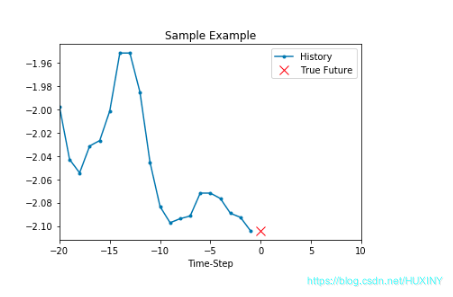0 前言
🔥 优质竞赛项目系列,今天要分享的是
机器学习大数据分析项目
该项目较为新颖,适合作为竞赛课题方向,学长非常推荐!
🧿 更多资料, 项目分享:
https://gitee.com/dancheng-senior/postgraduate
1 数据集介绍
df = pd.read_csv(‘/home/kesci/input/jena1246/jena_climate_2009_2016.csv’)
df.head()

如上所示,每10分钟记录一次观测值,一个小时内有6个观测值,一天有144(6x24)个观测值。
给定一个特定的时间,假设要预测未来6小时的温度。为了做出此预测,选择使用5天的观察时间。因此,创建一个包含最后720(5x144)个观测值的窗口以训练模型。
下面的函数返回上述时间窗以供模型训练。参数 history_size 是过去信息的滑动窗口大小。target_size
是模型需要学习预测的未来时间步,也作为需要被预测的标签。
下面使用数据的前300,000行当做训练数据集,其余的作为验证数据集。总计约2100天的训练数据。
def univariate_data(dataset, start_index, end_index, history_size, target_size):
data = []
labels = []
start_index = start_index + history_size
if end_index is None:
end_index = len(dataset) - target_size
for i in range(start_index, end_index):
indices = range(i-history_size, i)
# Reshape data from (history`1_size,) to (history_size, 1)
data.append(np.reshape(dataset[indices], (history_size, 1)))
labels.append(dataset[i+target_size])
return np.array(data), np.array(labels)
2 开始分析
2.1 单变量分析
首先,使用一个特征(温度)训练模型,并在使用该模型做预测。
2.1.1 温度变量
从数据集中提取温度
uni_data = df[‘T (degC)’]
uni_data.index = df[‘Date Time’]
uni_data.head()
观察数据随时间变化的情况

进行标准化
#标准化
uni_train_mean = uni_data[:TRAIN_SPLIT].mean()
uni_train_std = uni_data[:TRAIN_SPLIT].std()
uni_data = (uni_data-uni_train_mean)/uni_train_std
#写函数来划分特征和标签
univariate_past_history = 20
univariate_future_target = 0
x_train_uni, y_train_uni = univariate_data(uni_data, 0, TRAIN_SPLIT, # 起止区间
univariate_past_history,
univariate_future_target)
x_val_uni, y_val_uni = univariate_data(uni_data, TRAIN_SPLIT, None,
univariate_past_history,
univariate_future_target)
可见第一个样本的特征为前20个时间点的温度,其标签为第21个时间点的温度。根据同样的规律,第二个样本的特征为第2个时间点的温度值到第21个时间点的温度值,其标签为第22个时间点的温度……


2.2 将特征和标签切片
BATCH_SIZE = 256
BUFFER_SIZE = 10000
train_univariate = tf.data.Dataset.from_tensor_slices((x_train_uni, y_train_uni))
train_univariate = train_univariate.cache().shuffle(BUFFER_SIZE).batch(BATCH_SIZE).repeat()
val_univariate = tf.data.Dataset.from_tensor_slices((x_val_uni, y_val_uni))
val_univariate = val_univariate.batch(BATCH_SIZE).repeat()
2.3 建模
simple_lstm_model = tf.keras.models.Sequential([
tf.keras.layers.LSTM(8, input_shape=x_train_uni.shape[-2:]), # input_shape=(20,1) 不包含批处理维度
tf.keras.layers.Dense(1)
])
simple_lstm_model.compile(optimizer='adam', loss='mae')
2.4 训练模型
EVALUATION_INTERVAL = 200
EPOCHS = 10
simple_lstm_model.fit(train_univariate, epochs=EPOCHS,
steps_per_epoch=EVALUATION_INTERVAL,
validation_data=val_univariate, validation_steps=50)
训练过程

训练结果 - 温度预测结果

2.5 多变量分析
在这里,我们用过去的一些压强信息、温度信息以及密度信息来预测未来的一个时间点的温度。也就是说,数据集中应该包括压强信息、温度信息以及密度信息。
2.5.1 压强、温度、密度随时间变化绘图

2.5.2 将数据集转换为数组类型并标准化
dataset = features.values
data_mean = dataset[:TRAIN_SPLIT].mean(axis=0)
data_std = dataset[:TRAIN_SPLIT].std(axis=0)
dataset = (dataset-data_mean)/data_std
def multivariate_data(dataset, target, start_index, end_index, history_size,
target_size, step, single_step=False):
data = []
labels = []
start_index = start_index + history_size
if end_index is None:
end_index = len(dataset) - target_size
for i in range(start_index, end_index):
indices = range(i-history_size, i, step) # step表示滑动步长
data.append(dataset[indices])
if single_step:
labels.append(target[i+target_size])
else:
labels.append(target[i:i+target_size])
return np.array(data), np.array(labels)
2.5.3 多变量建模训练训练
single_step_model = tf.keras.models.Sequential()
single_step_model.add(tf.keras.layers.LSTM(32,
input_shape=x_train_single.shape[-2:]))
single_step_model.add(tf.keras.layers.Dense(1))
single_step_model.compile(optimizer=tf.keras.optimizers.RMSprop(), loss='mae')
single_step_history = single_step_model.fit(train_data_single, epochs=EPOCHS,
steps_per_epoch=EVALUATION_INTERVAL,
validation_data=val_data_single,
validation_steps=50)
def plot_train_history(history, title):
loss = history.history['loss']
val_loss = history.history['val_loss']
epochs = range(len(loss))
plt.figure()
plt.plot(epochs, loss, 'b', label='Training loss')
plt.plot(epochs, val_loss, 'r', label='Validation loss')
plt.title(title)
plt.legend()
plt.show()
plot_train_history(single_step_history,
'Single Step Training and validation loss')


6 最后
🧿 更多资料, 项目分享:




















 3076
3076











 被折叠的 条评论
为什么被折叠?
被折叠的 条评论
为什么被折叠?








